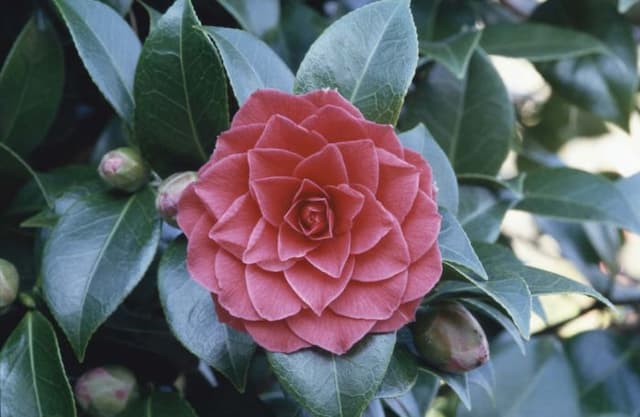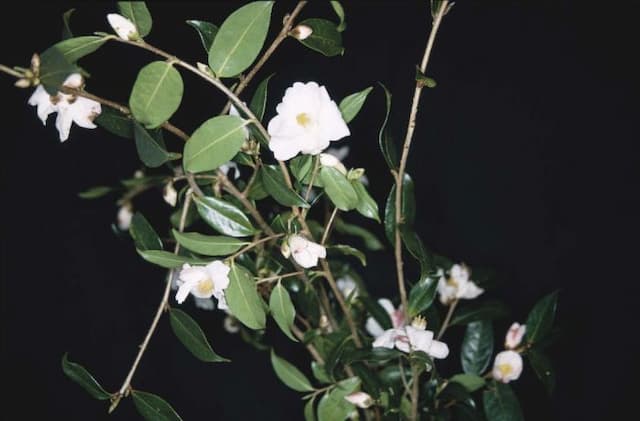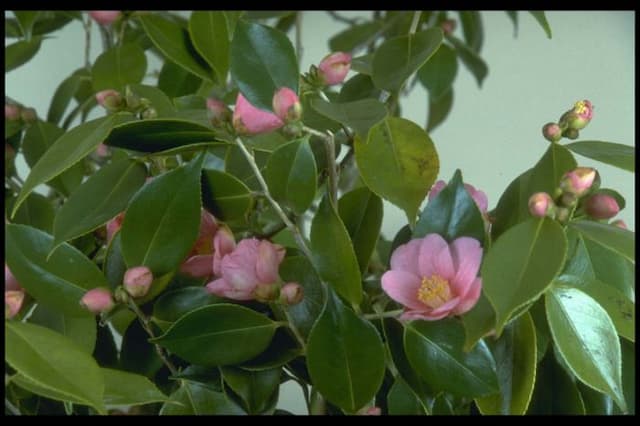Japanese Camellia Camellia japonica 'Mathotiana Alba'

ABOUT
Camellia japonica 'Mathotiana Alba', commonly known as the Japanese camellia, is an ornamental plant renowned for its strikingly beautiful flowers. It displays large, pristine white blossoms that can captivate any observer. These flowers are particularly noted for their elegant and formal double form, meaning the petals are arranged in several rows, creating a full, luxurious look that resembles a peony or a rose. The buds of the Japanese camellia are initially spherical, delicately unfurling to reveal layers of smooth, lustrous petals that can be up to three inches in diameter. The petals themselves are broad and have a slightly curved shape, contributing to the plant's overall graceful appearance. The Japanese camellia boasts glossy, dark green leaves which have a leathery texture. These leaves typically measure three inches long and contrast beautifully with the bright white blooms, further enhancing the flower's allure. The foliage is evergreen, providing year-round visual interest even when the plant is not in flower. Finally, the blooms are usually scentless, letting their visual splendor take the center stage without the addition of fragrance. However, even without a notable scent, Japanese camellia's elegant blooms make it a desirable choice for gardeners and landscapers. It's a striking plant that brings a touch of serene beauty wherever it is planted, with flowers that create a sense of tranquility and purity.
About this plant
 Names
NamesFamily
Theaceae
Synonyms
Japanese Camellia, Common Camellia, Rose Of Winter
Common names
Camellia japonica 'Mathotiana Alba'.
 Toxicity
ToxicityTo humans
The Japanese camellia is generally considered non-toxic to humans. There is no significant evidence to suggest that the ingestion of the Japanese camellia 'Mathotiana Alba' leads to poisoning or adverse health effects. Therefore, accidental ingestion of its parts is unlikely to cause more than mild gastrointestinal discomfort, if any symptoms occur at all. It's still advisable to avoid consuming this plant as it is not intended for human consumption, and individuals may have varying sensitivities.
To pets
The Japanese camellia is not known to be toxic to pets. It is not listed among the commonly recognized toxic plants for dogs, cats, or other domestic animals. Ingestion of this plant should not lead to any significant symptoms of poisoning in pets. As with any non-food plant, eating large amounts of foliage may cause mild gastrointestinal upset due to the ingestion of non-digestible matter, but no serious toxicity is expected. If a pet does ingest a large amount of the plant and shows signs of distress, it is best to consult a veterinarian.
 Characteristics
CharacteristicsLife cycle
Perennials
Foliage type
Evergreen
Color of leaves
Green
Flower color
White
Height
6-10 feet (1.8-3 meters)
Spread
6-10 feet (1.8-3 meters)
Plant type
Shrub
Hardiness zones
7
Native area
Japan
Benefits
 General Benefits
General Benefits- Ornamental Value: Camellia japonica 'Mathotiana Alba', commonly known as Camellia, adds aesthetic appeal to gardens with its large, pure white flowers and glossy dark green leaves.
- Long Blooming Season: Camellias typically bloom from winter to spring, providing color during a time when few other plants flower.
- Shade Tolerance: The plant thrives in partial shade, making it ideal for understory planting or shaded garden areas.
- Evergreen Foliage: As an evergreen, Camellia maintains its foliage throughout the year, offering continuous greenery.
- Habitat Support: The flowers provide nectar for pollinators such as bees during the blooming season.
- Versatility: Camellia can be used in various landscape designs, including formal gardens, as a hedge, or even as a container plant.
- Drought Resistance: Once established, Camellia plants can tolerate periods of dryness, reducing the need for frequent watering.
- Low Maintenance: Requiring minimal pruning and care once established, Camellias are an easy-to-care-for addition to any garden.
 Medical Properties
Medical PropertiesThis plant is not used for medical purposes.
 Air-purifying Qualities
Air-purifying QualitiesThis plant is not specifically known for air purifying qualities.
 Other Uses
Other Uses- Camellia japonica, commonly known as Japanese camellia, can be used in hair care products to add gloss and enhance texture due to its hydrating properties.
- Japanese camellia petals can be incorporated into floral jelly desserts, lending a subtle flavor and elegant presentation.
- The leaves of Camellia japonica can be crafted into a natural dye for fabrics, yielding a range of colors from green to brown hues.
- Artists use Camellia japonica's vibrant petals to create botanical prints by pressing them onto paper or fabric for an organic touch to their art.
- In woodworking, the leaves of the Japanese camellia can be used to polish fine furniture and woodwork, giving a natural shine and protective layer.
- Camellia japonica branches can serve as natural stakes for supporting other plants in a garden, offering a sustainable alternative to plastic or metal stakes.
- Petals of the Japanese camellia can be incorporated into eco-friendly confetti for use in celebrations, decomposing naturally without harming the environment.
- The waxy and durable leaves of Camellia japonica can be used as a natural wrapping material for small gifts or food items, adding an elegant and biodegradable touch.
- Beekeepers sometimes plant Japanese camellia near their hives as the winter blooms provide a source of nectar during a season when flowers are scarce.
- Camellia japonica seed oil is used in traditional Japanese woodworking tools maintenance to prevent rust and ensure smooth operation of the tools.
Interesting Facts
 Feng Shui
Feng ShuiThe Camellia is not used in Feng Shui practice.
 Zodiac Sign Compitability
Zodiac Sign CompitabilityThe Camellia is not used in astrology practice.
 Plant Symbolism
Plant Symbolism- Admiration: The Camellia japonica, commonly known as the Japanese camellia, symbolizes deep admiration and respect, embodying the beauty and perfection admired by the admirer.
- Perfection: With its exquisite form and pure color, the 'Mathotiana Alba' cultivar of the Japanese camellia represents the idea of perfection or flawless beauty.
- Love: Often given as a gift, camellias represent love, affection, and romantic desire, conveying a message of deep emotional connection.
- Longevity: The camellia's ability to live for many years is seen as a symbol of longevity and enduring life.
- Faithfulness: In some cultures, the camellia stands for faithfulness and loyalty in a relationship, reflecting the lasting nature of true love.
 Water
WaterThe Japanese Camellia requires consistent moisture, so water the plant when the top inch of soil feels dry to the touch. Typically, this means watering the plant deeply every week, though this frequency may need to increase during hot, dry periods. Use about 1 gallon of water for each watering session to ensure the soil becomes thoroughly moistened but not waterlogged. During the winter months, reduce watering slightly as the plant's growth slows down, but do not let the soil completely dry out.
 Light
LightJapanese Camellias prefer bright, indirect light and should be positioned in a location that receives morning light and partial shade in the afternoon. Avoid direct afternoon sun, as this can scorch the leaves. A spot with dappled sunlight under the canopy of tall trees is often ideal, providing just the right balance of light and protection.
 Temperature
TemperatureJapanese Camellias thrive in a moderate climate and can tolerate temperatures as low as 20 degrees Fahrenheit, though they prefer a range between 50 and 70 degrees Fahrenheit. Extreme heat above 85 degrees Fahrenheit can cause stress. It is important to protect them from cold winter winds and hot summer sun to maintain ideal temperature conditions.
 Pruning
PruningThe Japanese Camellia should be pruned to maintain shape, remove dead or crossing branches, and encourage healthy growth. Pruning is best done in late winter or early spring after flowering has finished, but before new growth starts. Lightly pruning the outer growth will help to stimulate bud development for the next season.
 Cleaning
CleaningAs needed
 Soil
SoilThe Japanese camellia 'Mathotiana Alba' thrives in acidic soil with a pH range of 5.5 to 6.5. The best soil mix is one that is rich in organic matter, well-draining, and has a composition of 1/3 peat moss, 1/3 perlite, and 1/3 organic compost to ensure proper aeration and moisture retention.
 Repotting
RepottingJapanese camellias like 'Mathotiana Alba' should be repotted approximately every 2-3 years, or when they become root-bound. Avoid repotting during their blooming period to prevent shock.
 Humidity & Misting
Humidity & MistingJapanese camellias 'Mathotiana Alba' require moderate to high humidity levels to thrive, ideally between 50-60%. Utilize a humidifier or place a water tray nearby to maintain consistent humidity without affecting the watering schedule.
 Suitable locations
Suitable locationsIndoor
Place in bright, indirect light and maintain high humidity.
Outdoor
Provide partial shade and shelter from strong winds.
Hardiness zone
7-9 USDA
 Life cycle
Life cycleCamellia japonica 'Mathotiana Alba', commonly known as White Japanese Camellia, begins its life cycle as a seed that germinates in suitable conditions, usually in shady, well-drained soil with acidic pH. After germination, the seedling grows into a young plant, developing a root system and foliage as it matures into an evergreen shrub. The shrub enters a vegetative stage, during which it focuses on producing a dense canopy of glossy, dark green leaves. Upon reaching maturity, which can take several years, the White Japanese Camellia starts the reproductive phase, blooming typically between winter and spring with large, showy white flowers that attract pollinators. Following pollination, the flowers produce seed capsules that eventually release seeds, completing the reproductive cycle. The plant can live for many years, sometimes over a century, continually growing and producing flowers annually.
 Propogation
PropogationPropogation time
Spring to Early Summer
Camellia japonica 'Mathotiana Alba', commonly known as the White Camellia, is best propagated through semi-hardwood cuttings. This method typically takes place during the late summer when the current season's growth has started to mature but isn't fully hardened. A cutting, consisting of 4 to 6 inches of the stem with several leaves, is taken from the parent plant. The lower leaves are removed, and the cut end is often dipped in rooting hormone to increase the chances of successful root development. The cutting is then inserted into a pot filled with a well-draining soil mixture, ensuring that the leaf nodes where the leaves were removed are beneath the soil surface. The pot must be kept in a warm location with indirect light and consistently moist soil until roots develop, which can take several weeks. Covering the pot with a plastic bag can help to maintain high humidity, which is beneficial for root growth.









